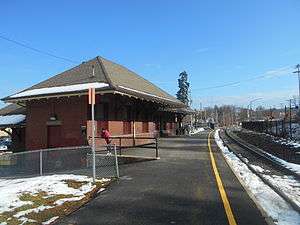Netcong station
Netcong | |||||||||||||||||||||||||||||
|---|---|---|---|---|---|---|---|---|---|---|---|---|---|---|---|---|---|---|---|---|---|---|---|---|---|---|---|---|---|
 Netcong Station in December 2014 from the station platform. U.S. Route 46 is visible to the right. | |||||||||||||||||||||||||||||
| Coordinates | 40°53′51.5″N 74°42′26.5″W / 40.897639°N 74.707361°WCoordinates: 40°53′51.5″N 74°42′26.5″W / 40.897639°N 74.707361°W | ||||||||||||||||||||||||||||
| Owned by | New Jersey Transit | ||||||||||||||||||||||||||||
| Line(s) | |||||||||||||||||||||||||||||
| Platforms | 1-low-level platform | ||||||||||||||||||||||||||||
| Tracks | 1 | ||||||||||||||||||||||||||||
| Connections |
| ||||||||||||||||||||||||||||
| Construction | |||||||||||||||||||||||||||||
| Parking | Free and no overnight parking | ||||||||||||||||||||||||||||
| Other information | |||||||||||||||||||||||||||||
| Fare zone | 19[1] | ||||||||||||||||||||||||||||
| History | |||||||||||||||||||||||||||||
| Opened | 1853[2] | ||||||||||||||||||||||||||||
| Rebuilt | 1901–June 14, 1903[3] | ||||||||||||||||||||||||||||
| Electrified | No | ||||||||||||||||||||||||||||
| Previous names | Netcong-Stanhope | ||||||||||||||||||||||||||||
| Traffic | |||||||||||||||||||||||||||||
| Passengers (2012) | 145 (average weekday)[4] | ||||||||||||||||||||||||||||
| Services | |||||||||||||||||||||||||||||
| |||||||||||||||||||||||||||||
Netcong is a New Jersey Transit station in Netcong, New Jersey. Located on U.S. Route 46 at Main Street in downtown Netcong, the small, 1-low level side platform station service passengers for the Morristown Line and the Montclair-Boonton Line. These lines provide service to Hoboken or to New York City via Midtown Direct on the Morristown Line at Dover and Montclair-Boonton at Montclair State University station. Midtown Direct service can also be transferred at Newark Broad Street Station in Newark, New Jersey There is one track and one platform on the north side, adjacent to the station. New Jersey Transit maintains a substantial train servicing yard east of the Netcong station at Port Morris in Roxbury Township. Port Morris Yard is proposed to return as the junction of the Montclair-Boonton and Morristown Lines for the Lackawanna Cut-Off line to Scranton. Transfers would be provided at Lake Hopatcong station in Landing.[5]
Service to Netcong, once known as South Stanhope, was begun in 1853 by the Morris & Essex Railroad. A 1.5-story depot was constructed by the railroad out of wood and located on the westbound tracks. The current Netcong station was built by the Delaware, Lackawanna and Western Railroad's main line after construction of the Stanhope Cut-Off from 1901–1903 as the main station to Netcong and nearby Stanhope.[6] The brick design of the station was built with bricks from nearby Port Murray, New Jersey.[7]
The station served as the junction of the Sussex Branch of the Delaware, Lackawanna and Western as well, serving towns through Sussex County including Branchville, Newton and Lafayette. Passenger railroad service on the Sussex Branch ended in October 1966, when the Erie-Lackawanna Railroad, the successor to the Lackawanna, cut service on many passenger branches. In 1979, the line was torn up and handed over to the New Jersey State Park Department. Prior to 1994, New Jersey Transit's service on the then-Boonton Line terminated at Netcong. However, in late 1994, service was extended along the Norfolk Southern owned tracks to Mount Olive and Hackettstown, which became the permanent western terminus of the line.[8]
See also
References
- ↑ "Montclair-Boonton Line Timetables" (PDF) (May 23, 2010 ed.). Newark, New Jersey: New Jersey Transit Rail Operations. 2010. pp. 1–4. Retrieved September 9, 2010.
- ↑ Rutan 2013, p. 13.
- ↑ Rutan 2013, p. 14.
- ↑ "QUARTERLY RIDERSHIP TRENDS ANALYSIS". New Jersey Transit. Archived from the original (PDF) on December 27, 2012. Retrieved January 4, 2013.
- ↑ "2007-2008 Annual Report" (PDF). New Jersey Association of Railroad Passengers. 2008. Retrieved May 17, 2010.
- ↑ Rutan 2013, p. 13-14.
- ↑ Yanosey, Robert J. (2007). Lackawanna Railroad Facilities (In Color). Volume 2: Dover to Scranton. Scotch Plains, New Jersey: Morning Sun Books Inc.
- ↑ Sanderson, Bill (November 6, 1994). "People Back Home Know Best". The Record. Bergen County, New Jersey: The Record of Bergen County.
Bibliography
- Rutan, Dave (2013). Remember The Sussex Branch of the Lackawanna Railroad. Sussex County, New Jersey: Dave Rutan. ISBN 9781304169310.
External links
![]() Media related to Netcong (NJT station) at Wikimedia Commons
Media related to Netcong (NJT station) at Wikimedia Commons